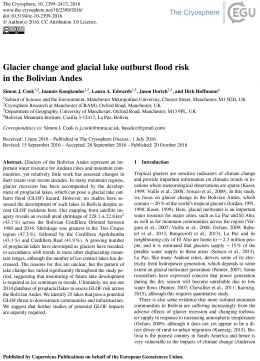Glacier change and glacial lake outburst flood risk in the Bolivian Andes
- Inicie sesión o regístrese para comentar
Year:
2016
Publisher:
The Cryosphere, 10, 2399–2413, 2016
. Glaciers of the Bolivian Andes represent an important
water resource for Andean cities and mountain communities,
yet relatively little work has assessed changes in
their extent over recent decades. In many mountain regions,
glacier recession has been accompanied by the development
of proglacial lakes, which can pose a glacial lake outburst
flood (GLOF) hazard. However, no studies have assessed
the development of such lakes in Bolivia despite recent
GLOF incidents here. Our mapping from satellite imagery
reveals an overall areal shrinkage of 228.1 ± 22.8 km2
(43.1 %) across the Bolivian Cordillera Oriental between
1986 and 2014. Shrinkage was greatest in the Tres Cruces
region (47.3 %), followed by the Cordillera Apolobamba
(43.1 %) and Cordillera Real (41.9 %). A growing number
of proglacial lakes have developed as glaciers have receded,
in accordance with trends in most other deglaciating mountain
ranges, although the number of ice-contact lakes has decreased.
The reasons for this are unclear, but the pattern of
lake change has varied significantly throughout the study period,
suggesting that monitoring of future lake development
is required as ice continues to recede. Ultimately, we use our
2014 database of proglacial lakes to assess GLOF risk across
the Bolivian Andes. We identify 25 lakes that pose a potential
GLOF threat to downstream communities and infrastructure.
We suggest that further studies of potential GLOF impacts
are urgently required.
ISSN:
doi:10.5194/tc-10-2399-2016
Work regions:
Publication Type:
Publication language:
English

Files:
